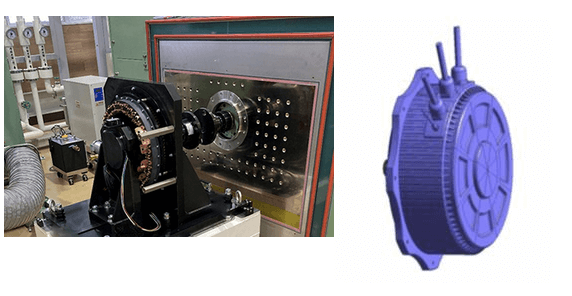The Japanese company IHI has succeeded in developing a compact 250 kW electric motor prototype for a hybrid propulsion system. IHI plans to increase the power of the motor to more than 1 MW and install it as a hybrid electric propulsion system in a medium-sized 200-seat passenger aircraft.
A 250 kW electric motor for a hybrid system
The (very) large Japanese company IHI has successfully developed a prototype electric motor with a power of 250 kW to power an aircraft, in collaboration with Akita Prefectural University, Akita University and local companies in Akita Prefecture. The electric motor is developed as a hybrid electric propulsion system. With an output of 250 kW, the motor has a high power output comparable to that of a 3-liter turbocharged internal combustion engine of a passenger car, and the motor core, which consists of permanent magnets and an iron core, has a compact design with a volume of about 3 liters.IHI is planning to increase the power output of the motor to more than 1 MW and install it as a hybrid electric propulsion system in a medium-sized 200-seat passenger aircraft.
IHI plans to increase the motor's power to more than 1 MW...
This development is the result of a collaboration between the Joint Research Center for Electric Architecture, jointly led by Akita Prefectural University and the University of Akita, as part of a cabinet project funded by the Subsidy for Regional University & Regional Industry Creation Project for Industry Creation, IHI and local companies in Akita Prefecture. The permanent magnets are arranged in a high-density magnetic array (Halbach array*) to maximize the efficiency of magnet utilization and achieve high efficiency (high performance), size reduction and weight reduction. In a Halbach array, the arrangement of permanent magnets is special. For a general magnet arrangement, both sides have the same magnetic force, but the magnetic force on one side of the arrangement is increased and the magnetic force on the opposite side is reduced to almost zero, which maximizes the efficiency of magnet utilization.
...For a 200-seat aircraft
As part of this development, IHI collaborated on the structural design of the prototype and solved the manufacturing issues of the stator (non-rotating part of the motor). To achieve a compact, lightweight, high-power motor, the rotor must have a high-density magnetic arrangement so that the individual magnets have a strong repulsive force, and the stator must have a high-density arrangement of high-power coils in many slots (grooves), each of which is considered difficult to industrialize using conventional manufacturing methods. However, IHI has now overcome these problems by developing manufacturing methods for the coils and cores (iron cores).
IHI will continue to work on the development of a hybrid electric propulsion system for aircraft electrification for practical use in the 2030s, and will also work on the electrification and optimization of the entire aviation system.
Découvrez cet article sur Air&Cosmos

